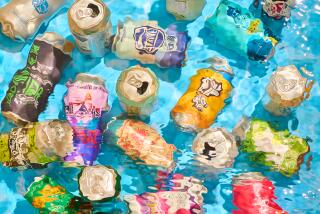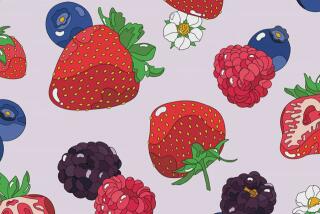Just ripe for summer
One of the most elegant summertime aperitifs is an effervescent drink that is as dry as your favorite white wine, intensely citrusy in taste and leaves a lingering impression of strawberries.
It’s neither a wine nor a cocktail but a beer -- and one more deserving of a champagne flute than a stein: Hanssens Oudbeitje, a Belgian beer brewed with whole strawberries that are fermented so completely they’re little more than a memory on the palate.
In Belgium, fruit beers made with everything from cherries to bananas are an old tradition, a marker for high summer. And lately, small American breweries have begun to mimic them.
But you don’t have to be a beer geek to notice the enormous difference between the domestics and the Belgians. The Belgians traditionally incorporate whole fruit in the fermentation process. Skin, pith, seeds and pits impart not only real-fruit intensity but other complex flavors as well.
The American beers are, for the most part, wheat beers with fruit juice or “natural flavors” added. That means those beers tend to have an artificial aroma or taste. Although acceptable enough as warm-weather quaffs, they don’t ring a connoisseur’s bell.
“Fruit beer came on the American scene in the early 1990s, but it hasn’t evolved into anything near the level it has in Belgium,” says Mark Jilg of Pasadena’s Craftsman Brewing Co., maker of Orange Grove Ale, a draft-only beer fermented with chopped Valencia oranges in the Belgian style.
The Belgian fruit beers belong to a unique category of Belgian brews called lambics, wheat-based beers that are fermented by wild (as opposed to cultured) yeasts in wooden barrels, some quite old. The practice results in beers that are typically dry, crisp, white wine-like brews with noticeable earthy qualities.
Most lambics are fermented plain, but the acidic nature of the style makes it nicely suited to being brewed with black cherries (the resulting beer is called kriek), raspberries (called framboise or frambozen), strawberries (fraises), peaches (peche) and black currants (cassis), among other fruits.
In a recent tasting of 13 Belgian fruit lambics available in the Los Angeles region, those brewed in the traditional manner -- to be very dry and complex -- were most appealing. In addition to the Hanssens Oudbeitje, two beers from Liefmans best demonstrated the dry, complex old style.
Liefmans Kriek had a dull reddish cast and a funky, earthy aroma that hints of cherries. As with the Hanssens strawberries, the cherries showed primarily in the aftertaste. The same can be said of the raspberries in Liefmans Frambozen Bier, a pale, brownish brew that is even drier than Liefmans Kriek, courtesy no doubt of the extra tannins from the raspberries’ numerous seeds.
A flute of any of the three and a drinker is primed to devour a grill-full of baby back ribs.
The most widely available fruit lambics are from Lindemans, whose fruit beers retain the earthy complexities of the traditional style but are markedly sweet and perhaps better suited to drinking after a meal.
Lindemans Kriek is pale red and has a pinkish foam. Its aroma hints of the barnyard but its flavor is a perfectly accurate rendition of black cherries, and its sweetness is ultimately offset by a dry finish.
Lindemans Framboise is redder than Lindemans Kriek and carries an intense raspberry aroma. It tastes throughout of sweet-sour raspberries, even after swallowing.
Somewhat less sweet is Lindemans Peche, a pale yellow brew that smells subtly of peaches. Its peachy sweetness plays out against a more noticeably sour background than the other Lindemans fruit lambics.
Lindemans Cassis, which is harder to find than the other flavors, is the most idiosyncratic of the house’s fruit beers. It pours winy purple with a pink head and smells intensely of black currant with hints of juniper. It is the least sweet of the four Lindemans products but not so much dry as possessing a good dose of cassis sourness. It leaves a slight sensation of coolness in the mouth.
Fruit lambics from two other houses, Cherish and Chapeau, also were sampled.
Cherish Kriek Lambic smelled of maraschino cherries but lacked the earthiness that is a signature of the lambic-beer style. It was sweet but less so than its Lindemans counterpart. Cherish Peach and Cherish Raspberry showed some of the earthiness and proved drier than the kriek. All the Cherish beers are on the thin side.
Like the Lindemans beers, the Chapeau fruit lambics -- Fraises, Framboise and Banana -- proved markedly sweet, but their fruitness tended toward the one-dimensional, with a lack of earthiness.
Their character may have something to do with the fact that they’re “flavored with natural juice,” according to their labels, rather than with whole fruit. Chapeau Banana tasted a lot like those old-fashioned orange marshmallow candies shaped like circus peanuts.
Lindemans beers can be found in supermarkets and liquor stores (the 13 beers sampled for this article were collected from Whole Foods in Pasadena, Red Carpet Wine and Spirits in Glendale and the Green Jug in Woodland Hills). Depending on where you live, some of the fruit brews may require some hunting down.
They range in price from about $3.50 to about $5.50 for bottles ranging from 6 ounces to 12 ounces.
Fruit beers come in bottles that are corked and, in many cases, capped too. That means if you take up a bottle you’ll have to open it twice. That extra step is symbolic of the two-stage drinking experience of fruit beers that starts with the refreshing flavor of wheat beer and finishes with a fresh-fruit aftertaste that can linger like a summer’s evening.


